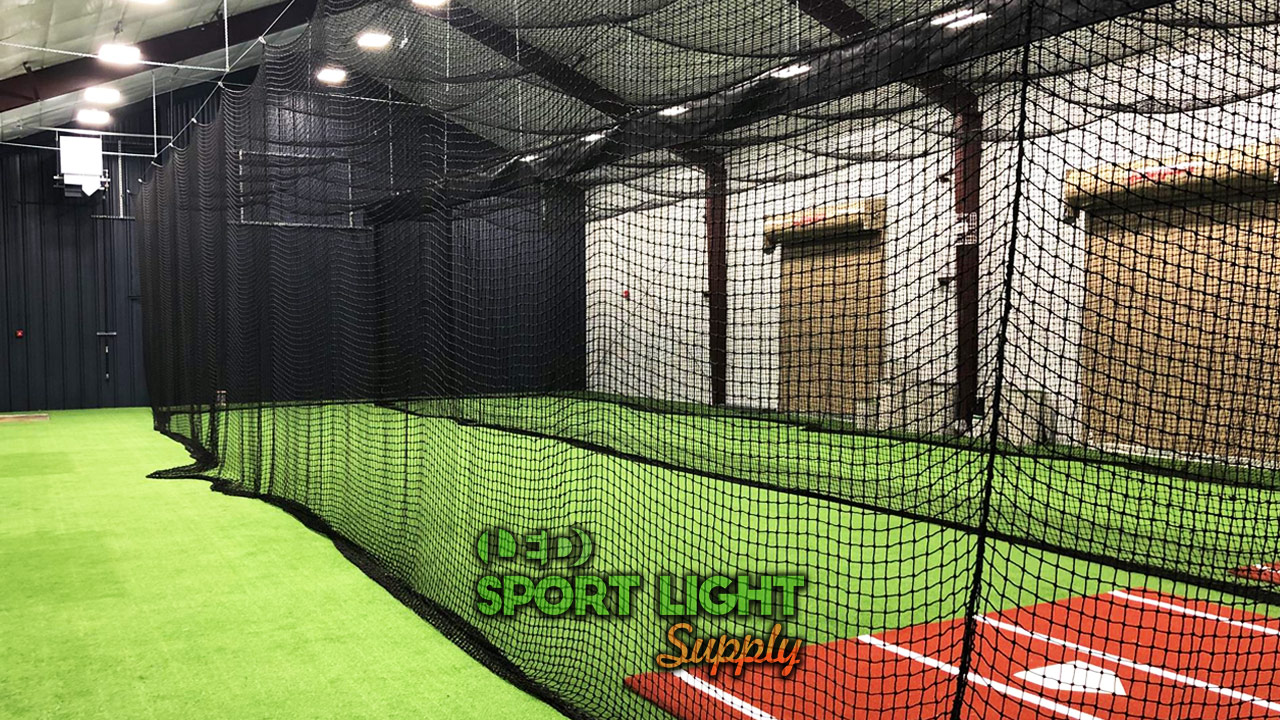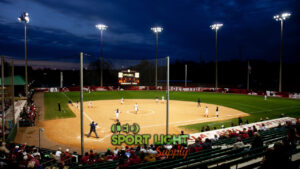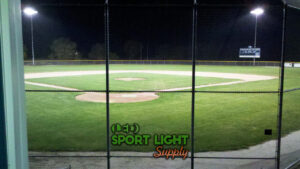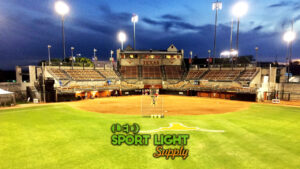Many famous baseball players were raised in a cage, the batting cage. Indeed, this piece of baseball facility equipment is vital. So much that more than one recommended lighting requirement exists.
Standard bulbs cannot always provide the correct lux level of illuminance. So, here is what you need to know to light a batting cage properly.
First, you are gonna read why the appropriate light level matters. We are going to touch on the importance of LED lights, but you will read more about it later. Then, you will find out what the lux requirements are. Along with other crucial information. For example, the differences between lighting standards for indoor and outdoor batting cages. And common installation problems (and how to fix them) as well.
Importance of batting cage lighting standard
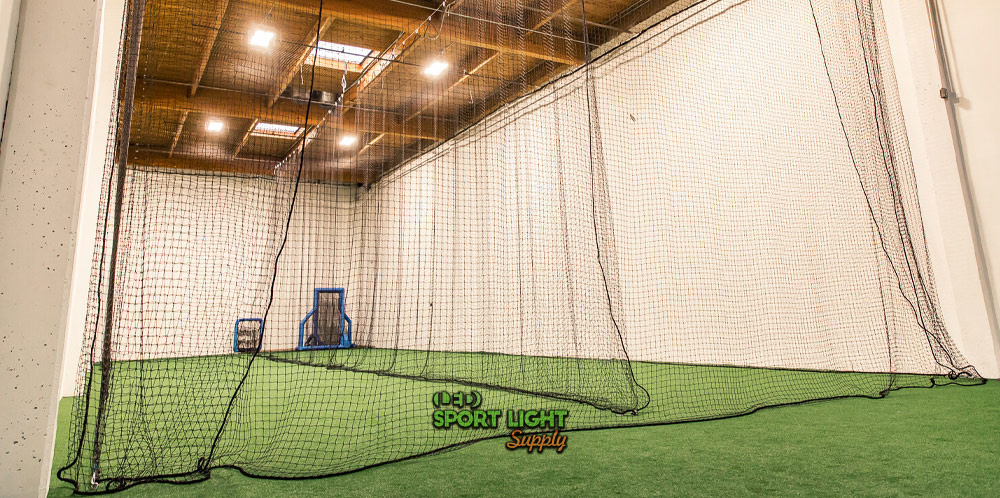
In the batting cage, the hitter’s eyes must be fixed on the ball. Moreover, even a single blink can lead to miss it. But making contact with a high-speed baseball can be impossible if the batter cannot see. To put it bluntly, uniform lighting can make or break any training effort to barrel it up.
Glare should never be a problem in a batting cage. But if its position is near one of the standard bright lights that light up the baseball diamond, excessive brightness can be a problem. Knowing about these kinds of issues makes all the difference in setting up the batting cage lighting.
Here are the three most critical reasons why you should care about the lighting layout and its lux level.
1. Baseball players’ experience
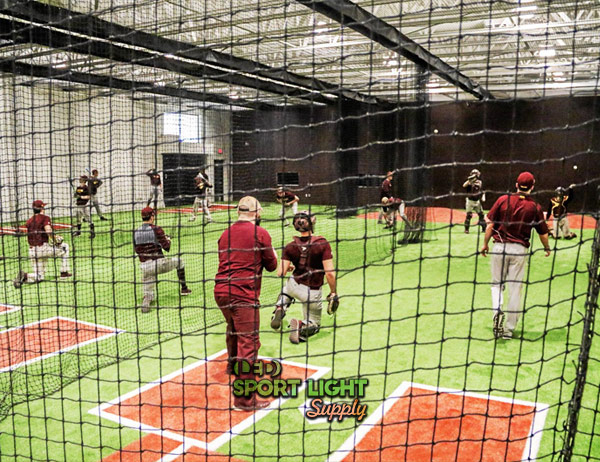 The main goal is to achieve bright and uniform lighting, so the baseball players can have better vision. After all, artificial light replicates natural sunlight and its effects. This also applies to the baseball player’s psychology. In fact, any well-lit environment enhances your performance. On the other hand, a dark place and flickering lights set a very different mood.
The main goal is to achieve bright and uniform lighting, so the baseball players can have better vision. After all, artificial light replicates natural sunlight and its effects. This also applies to the baseball player’s psychology. In fact, any well-lit environment enhances your performance. On the other hand, a dark place and flickering lights set a very different mood.
On a psychological level, light serves to ward off fear. The young batter can focus on improving the grip and stance. In short, proper lighting help hitters to build their confidence in themselves.
In the indoor baseball facility, the coach could also change the approach. For example, by using the lux requirement for games. In this way, the training sessions become more intense. Even if the batter does not notice it, the body response to varying light levels changes.
2. Safety of baseball players
For one thing, it must be remembered that the baseball player is never alone inside the batting cage. In fact, you must take the pitching machine into consideration. If the lighting conditions are not ideal, the baseball could hurt the batter.
Poor lighting must not hinder the hitter’s comfort and performance. On the contrary, the flood lighting system must help the player see fast-moving baseballs.
Outdoor, suitable lighting prevents any incident due to loose dirt or waterlogged lawns. Slipping or hitting something on uneven ground could also lead to injury. Most likely, the batter is there only to swing the baseball bat and hit the ball. But all sorts of bad things can happen before the player starts practicing if he or she cannot see the danger in full view.
3. Security of indoor baseball facility
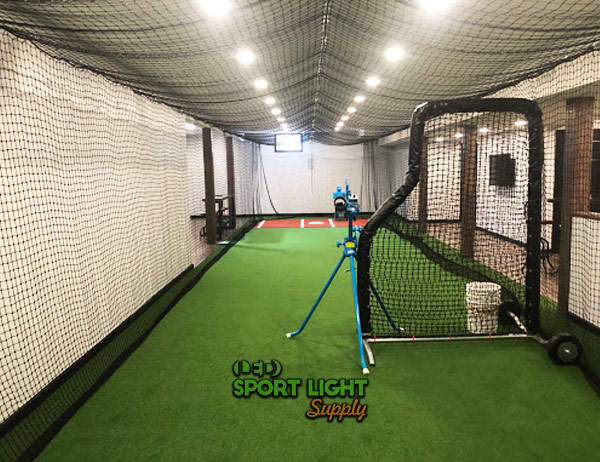 Most flood light models are great to secure the perimeter of your backyard or sports facility. For example, you can buy a motion sensor light. The lights in baseball field will turn on automatically with any unauthorized entry.
Most flood light models are great to secure the perimeter of your backyard or sports facility. For example, you can buy a motion sensor light. The lights in baseball field will turn on automatically with any unauthorized entry.
Thanks to energy-efficient LED light fixtures, you can use the light to deter criminal activity. You can always leave your batting cage lights on if you need to go away for a couple of hours.
Another useful feature is the remote control. In detail, it can improve the effectiveness of the video surveillance system. That is, you can create a lighting profile to provide more diffuse light before dusk. In this way, the light source will make sure that the system can record everything clearly. Later, when the profile switches off, the night vision security cameras can do their work without errors.
What are the lighting requirements of a batting cage?
The goal of having lighting requirements is to reproduce the same feeling of the batter’s box. In fact, the correct light level is not only useful to light up the batter mat. The lighting layout helps the baseball player to focus on gaining new skills.
Everything you observe in a space (volumes, shapes, colors, surface textures) is the manifestation of light. For example, when you see the baseball moving, you are actually perceiving the light reflected from its surface.
Rules for lighting a batting cage set the ideal values for each training session. Then again, specific drills could be necessary. Perhaps, the player needs to refine the batting mechanics or fix some bad habits. For instance, not running immediately after hitting the ball. So, you need everything set to train with the right state of mind.
Here are the seven most influential factors you need to consider.
1. Lux (brightness) requirement
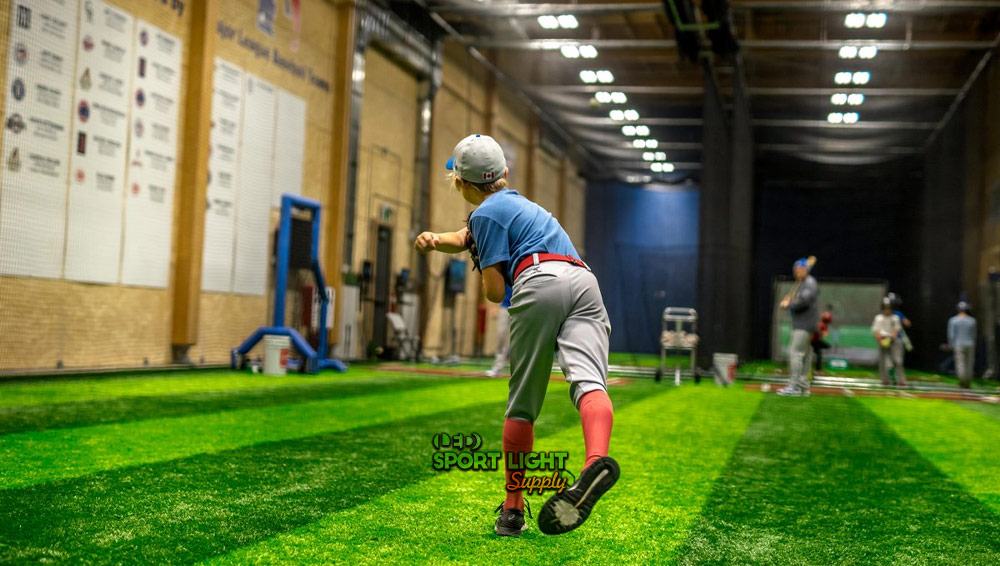
When you want to correctly illuminate an area, you need to find the optimal baseball batting cage lux level. When LED lamps came into the market, the terms lumens, footcandles, and lux have also become common.
Lux is a significant photometric unit of measurement. But with all the specs on the product packages, it is easy to get confused. Illuminance is the measurement of the luminous flux per unit area or visible flux density. Lux expresses the brightness in lumens per square meter (1 lux = 1 lm/sq.m).
Here are the recommended lux levels for batting cages:
- Residential: 150 to 300 lux
- Baseball club/high school/college: 400 to 500 lux
- Professional/televised venue: 700 to 1000 lux
According to where you place the batting cage, just calculate the necessary lumen output. In other words, divide the lux level by the batting cage area.
2. Lighting uniformity
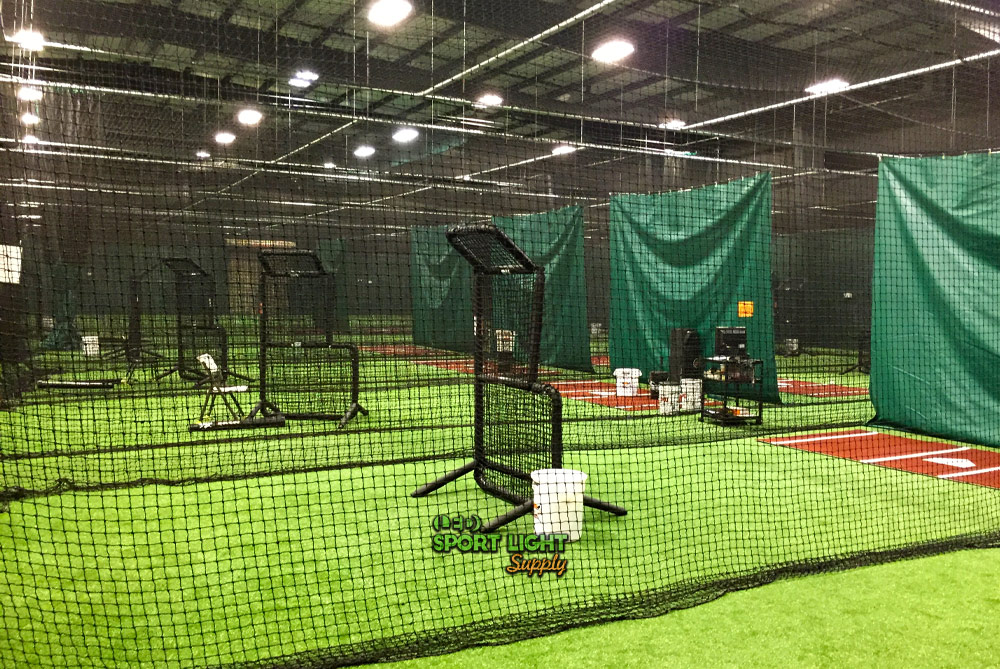
In addition to the luminous flux, other non-negligible variables intervene. For example, glare, color rendering, shadows, contrast factor, and uniformity of illumination.
Uniformity depends on the type of lights and their arrangement. In plain terms, uniformity is light distribution. If the light distribution is even, you can see everything clearly. After you install the light fixtures, you must check the uniformity of lighting.
Just divide the distance between two light bodies by the height. By height, I mean the perpendicular distance between the light sources and the ground. For the best results, place the light bodies on the same horizontal axis. Make sure the uniformity is somewhere between these values, according to the intended use:
- Recreational: 0.4 to 0.5
- Professional: 0.6 to 0.7
3. Beam angle
An outdoor batting cage could make you install the flood lights on walls or poles. So, you need to select an appropriate beam angle for each light. Similarly, in an indoor baseball facility, you can save on the electric bill by choosing the right one.
Each light body has its own beam angle. For example, flood lights come with a wide-angle. On the other hand, spot lights produce a narrow beam of light. Usually, you use flood lights for close range and spot lights to spread light over a longer distance.
Outdoor, you adjust to what you can use. But, in an indoor baseball facility, you should have:
- for a low ceiling, flood lights with 90 to 120 degrees beam angle
- for a high ceiling, a spot light with 25 to 45 degrees beam angle
4. Glare
The number of lamps and their arrangement must guarantee uniformity of lighting and avoid glare. Glare is a disturbing visual effect caused by an uneven light distribution or high contrast.
High-quality light output means that the light does not cause any glare. In fact, two types of glare exist. They are direct and indirect glare. You might also find anti-glare accessories for some kind of lamps.
Most light designers calculate the Glare rating of a light source to eliminate this problem. In detail, a Glare rating <50 is recommendable for any batting cage.
The formula for calculating the Unified Glare Rating is quite complex. In case you are experiencing glare, you should hire an expert. To try it out, tilt the LED light in several directions. Or slightly dim the brightness if your model comes with a lighting control system.
5. Color temperature
The human eye evaluates the intensity of the many luminous wavelengths to different degrees. To be precise, each color contains quantities of radiant energy. Plus, colors affect us and leave different impressions on us. We react differently to specific wavelengths of light.
Light sources always emit a variety of different wavelengths, but we perceive them as a single color. That is, the color temperature. Mostly, the standard color of various lights changes because of the material. LED lights are available both in warm or cool white. So, LED fixtures are a common choice for batting cage lighting. In detail, warm white (2,500-5,000 K) tends to be a tad yellowish. Cool white (5,000-7,000 K) is the bright white light, which contains more blue light. More on this later.
Some baseball players might prefer a warm white light because it is similar to daylight. Others might fancy a cool white light because it helps them focus on the ball better.
6. Shadow
Light and shadow are two concepts that are difficult to separate, at least in real life. But when it comes to batting cage lighting, you should aim for soft shadows. The light must be soft and uniform. The goal is to prevent the creation of sharp shadows or contrasts.
During official games, lux levels and light positions allow for soft or no shadows on the baseball diamond. In the batting cage, you should have adequate lighting spacing. The LED lighting should light the hitter from different sides. At the very least, the shadows should not hinder the player’s field of vision.
Side light is great to ensure good visibility. Especially when homogeneous lighting cannot be obtained from all directions.
7. Flicker-free
One thing you should do is buying flicker-free LED lights. If you plan to use LED light fixtures, here is some info on flickering.
Numerous studies have shown that flicker, even if completely invisible to the human eye, can cause:
- migraines
- eyestrain
- nausea
Normally, it is just a feeling of general discomfort, bound to go away when you turn off the lights. But in some cases, with sensitive subjects and prolonged exposure, it can affect visual acuity and health in general in the medium term.
You will notice that if the indoor baseball facility has flickering lights, players get tired earlier. In other words, the flicker can nullify or reduce the positive effect of long hours of training. Women and children are more sensitive to these effects. On average, men and older people seem to be slightly less bothered by this issue.
Difference between indoor and outdoor lighting standard of batting cage
1. Indoor batting cage light
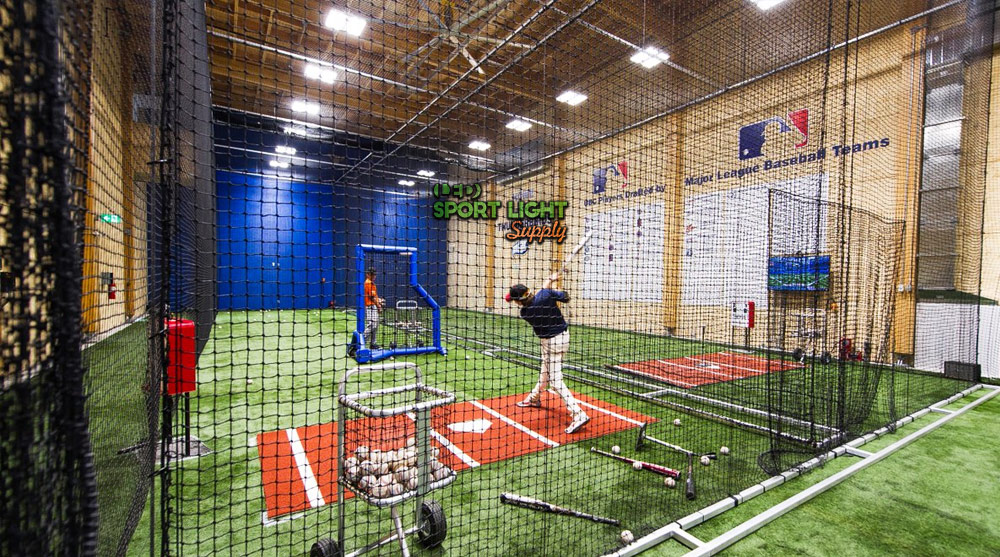
You can use both indirect or direct lighting. Indirect lighting refers to pointing the light upward. In this way, you can use the reflected light beam to light the batting cage. On the other hand, you obtain direct lighting by pointing the light downward.
On balance, indirect lighting usually gives you higher lighting uniformity. The batters also seem to enjoy it better than the other type. But the lighting cost gets higher as you need to use more powerful lights. In fact, you must take into consideration that the reflection causes some light loss.
As you can imagine, you cannot point a light upward for outdoor lighting. So, indirect lighting is specially designed to work with indoor batting cage lights.
2. Outdoor batting cage lights
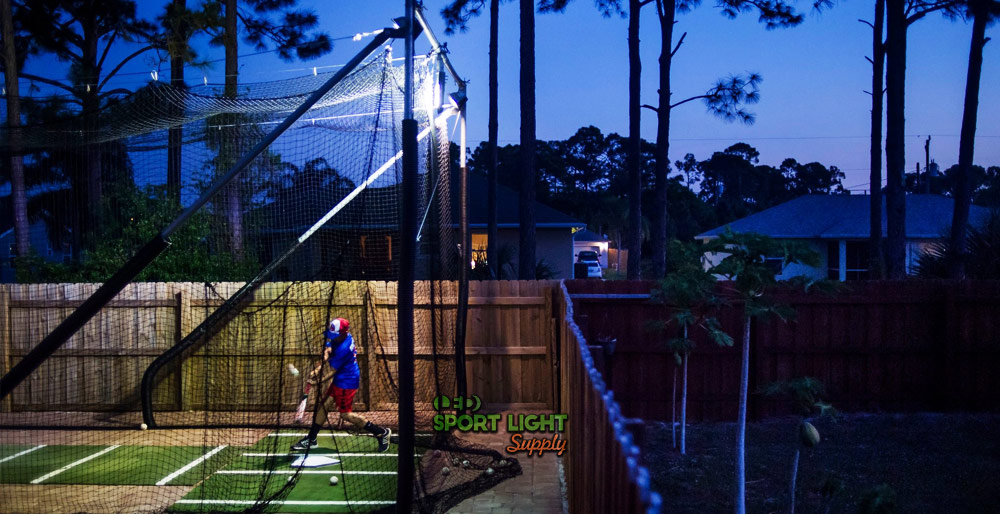
The main problem with outdoor batting cage lighting is light pollution. So, you must actively focus on spill light to prevent it from bothering wildlife and people alike.
The spill light will travel to neighboring areas. Of course, light pollution does not occur within indoor baseball facilities. Mostly because you install the lights on the ceiling and point them downward. Basically, you just need to consider the spacing between the ceiling lights.
Mainly, artificial lighting can cause this problem because of the lighting installation. For one thing, you need to correctly position the light poles. Depending on the lighting layout (4, 6, or 8 pole arrangement scheme), the issue will be more or less hard to fix.
The angle of projection (tilting) of the lights is also a critical factor. To specify, you need a photometric (DIALux) study to know where to point the flood lights. In an indoor baseball facility, there is no need to consider the projection angle of the lights.
Common problems of batting cage lights
1. The lights are too bright in batting cages
Excess brightness produces negative effects such as glare and reduction of safety conditions. For example, too bright light inhibits the production of melatonin. At night, it makes you sleep less, making you nervous the day after.
Luckily, it is easy to fix this problem. You should consider the lumens instead of power (watts) when buying the lights. In reality, the lumen per watt ratio is way more useful than considering the wattage.
Now you know about lux. Multiply that number for the area you need to cover (in squared meters). Well, here is the necessary lumen output.
You can calculate the lumen per watt ratio of each light and find how many you need. Or use the wattage equivalence chart that LED lights popularized so much.
2. Lights are too dim
Dim light is important, but only during romantic dates. In the batting cage, too dim lights will not let you see the baseball. Of course, this problem leads to numerous safety risks and potential accidents.
Today’s LED lights let you dim the brightness. But you should never dim down the lights too much. For one thing, you will violate the lighting standard. In fact, reducing brightness levels equals less lumen output.
A dim bulb should suggest to you that it is time to replace the light. After all, the light efficiency of any light source decreases over time. LED lights have the longest life span among the current products on the market. But LED flood lights can break or age too.
3. Selecting the wrong beam angle
A batter needs concentration to hit a ball for a big fly. But if you select the wrong beam angle, you will not create adequate light conditions.
Lights with broader beam angles are ideal for short-range illumination. In detail, they distribute light perfectly all over the batting cage.
Bright and dim spots on the batting cage ground can distract the hitter. More importantly, it can cause eye strain, dizziness, and, indirectly, bad posture.
The narrower the beam angle, the more focused the light beam will be on a precise point. Compared to solutions with a wider angle, the luminous flux will be more intense. So, always remember to use spot lights for long-range lighting.
4. Wrong light color temperature
LED lighting offers the full spectrum of possible color temperatures. In other words, it provides the possibility of an accurate choice of light color for different needs and purposes.
Nonetheless, you should aim for a comfortable vision. If the color temperature is below 2,800 K, the light will be too yellowish. If above 6,500 K, the light will become too bluish.
You can use 5,000 K lights to recreate natural daylight. Both in an outdoor batting cage and inside an indoor baseball facility.
No lighting requirement demands you choose a particular color temperature. But you should avoid the extreme shades because they mess with the color rendering. In short, you should want the light sources to illuminate objects as daylight would. Otherwise, batters might associate a specific light condition with the needed concentration. Thus, performing poorly on the diamond, where it matters the most.
Conclusion
After discussing all the relevant details, here is a final recap of the most used batting cage lighting standards.
The standard 23x4x3,5 meters (70x14x12 feet) batting cage in your backyard needs 150 to 300 lux.
For the baseball club’s batting cage, the lighting requirement ranges between 400 and 500 lux.
An indoor baseball facility can vary this value accordingly with the type of training. But overall, high school and college sports facilities should remain within these values.
Only professional baseball stadium lighting needs more lux. In fact, the brightness required for televised venues cannot be below 700, nor above 1,000 lux.

